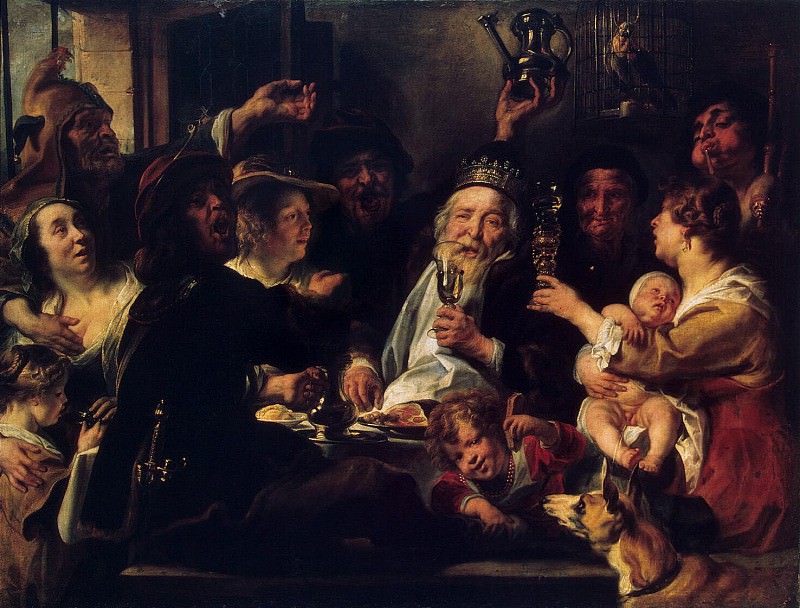The Bean King3 Jacob Jordaens (1593-1678)
Jacob Jordaens – The Bean King3
Edit attribution
Image taken from other album: gallerix.org/s/297965802/N/786975097/
Download full size: 1476×1120 px (0,3 Mb)
Painter: Jacob Jordaens
The Baroque artist Jacob Jordaens became a highly sought-after artistic master even during his lifetime. He was remarkable for his amazing creativity - more than 700 canvases have remained in the heritage of world culture. Life in Flemish enjoyed the painter’s unfailing interest, especially the moments of celebration by the common people. "The Bean King" of 1638 is a painting with an amazing backstory.
Description of Jacob Jordaens’s painting The Bean King
The Baroque artist Jacob Jordaens became a highly sought-after artistic master even during his lifetime. He was remarkable for his amazing creativity - more than 700 canvases have remained in the heritage of world culture. Life in Flemish enjoyed the painter’s unfailing interest, especially the moments of celebration by the common people.
"The Bean King" of 1638 is a painting with an amazing backstory. The local people had a tradition - to celebrate a religious holiday in a special way. On the eve of January 6 here gathered lavish feasts, at which by lottery was raffled off for the honorary seat of the king. The king could choose a queen from among those present and appoint the rest of the entourage: various ministers and a jester.
The party chief was chosen with the help of a bean, which was put in the dough before dinner, and whoever got the pie with the cherished grain won. The bean was chosen for a reason: it symbolized the guiding star of Bethlehem, which led the Magi to Christ. Such a tradition amused and entertained the common people, and at the same time relieved some of the tension with respect to authority figures.
Jordaens paints the moment when the guests are already tipsy and in the rhythm of a single mood they indulge in self-forgetful merriment. At the center of the composition is the chosen bean king. He is surrounded by loyal "subjects": women and men of different ages. The peculiarity of these paintings is the constant presence of children and animals.
This is the unity and generality of the people: an elderly lady in the background smiling approvingly and reservedly; the musician beside her forgotten in a groggy doze; a sitting mother with a baby completely forgotten about the languishing baby on her lap; on the left a middle-aged woman gives wine to her little daughter, as if unnoticed. The implements of the meal and raised glasses complete the atmosphere of the painting.
In a loose manner, the painter showed a warm and cheerful scene of life of his compatriots.
Кому понравилось
Пожалуйста, подождите
На эту операцию может потребоваться несколько секунд.
Информация появится в новом окне,
если открытие новых окон не запрещено в настройках вашего браузера.
You need to login
Для работы с коллекциями – пожалуйста, войдите в аккаунт (open in new window).




















You cannot comment Why?
The composition is characterized by a dynamic arrangement of figures, creating a sense of movement and energy. Several characters raise their hands in gestures of cheer, while others sing loudly, contributing to the overall atmosphere of unrestrained joy. A woman on the left cradles a child, her gaze directed towards the central figure, suggesting familial connection and participation in the festivities. To the right, another woman holds an infant, her expression mirroring the general air of contentment.
The artist has employed a dramatic use of light and shadow to accentuate certain figures and create depth within the scene. The illumination focuses primarily on the central table and the individuals immediately surrounding it, while the background remains relatively dark and indistinct. This technique draws the viewers attention to the core action and enhances the emotional intensity of the moment.
A small birdcage is visible in the upper right corner, a detail that introduces an element of potential irony or commentary. The caged bird might symbolize restriction or confinement, contrasting with the unrestrained freedom displayed by those participating in the celebration. Similarly, the presence of a dog at the foot of the table could be interpreted as representing loyalty and companionship within this lively group.
The painting’s subtexts suggest themes of abundance, social hierarchy, and perhaps even satire. The lavish display of food and drink implies prosperity or an exaggerated sense of wealth. The crowned figures position of authority is reinforced by his central placement and the deference shown to him by those around him. However, the overall tone of unrestrained revelry hints at a possible critique of excess or a playful commentary on societal norms. The scene’s informality and lack of refinement suggest that this celebration might be taking place amongst individuals who are not typically associated with such displays of opulence.